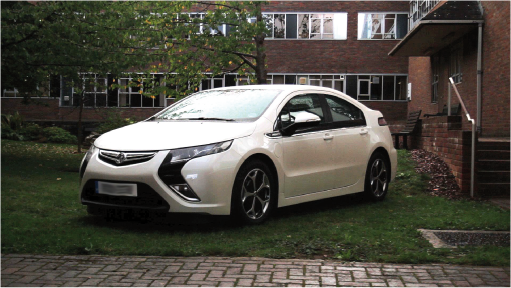'Plug-in' electric/petrol hybrid
As you saw in Section 5.2, hybrid vehicles use a battery and electric engine to improve the fuel efficiency of their internal combustion engine. They only run on electric power alone for limited slow-speed manoeuvring. 'Plug-in hybrid electric vehicles' (PHEVs) use this hybrid configuration to operate more on electric power. They thus have a larger battery than ordinary hybrid cars, with some running for 50 kilometres (30 miles) or more before the ICE cuts in; the ICE then runs as an efficient generator to provide power for the car's electric motors.
A key advantage of this configuration is that it overcomes the range limitation of a BEV while still allowing the car to run entirely on electricity for shorter trips. A further advantage is that these cars have the potential to be even more efficient than conventional hybrids, because (when used) the ICE runs at closer to its maximum efficiency.
The term 'plug-in hybrid electric vehicle' can lead to confusion between such cars and ordinary hybrids, and the term 'extended-range electric vehicle' is now also used to describe this technology. You should now watch Video 3, which explains how a plug-in hybrid works. This features the Opel/Vauxhall Ampera (Figure 16) which, under its US branding as the Chevrolet Volt, was the first extended-range electric vehicle to market: it was launched in the USA in 2011. About 25 000 US sales are expected in 2012, and Vauxhall also anticipates selling up to 3000 Amperas in the UK during 2012, largely to fleet buyers.
Transcript: Video 3 How a plug-in hybrid works

The Ampera can travel around 60 kilometres (possibly up to 80 km if driven carefully) on its lithium-ion battery pack before the ICE cuts in. At £30 000 the Ampera is an expensive car for its class, but it qualifies for the £5000 UK plug-in grant. As with all low-carbon vehicles, there is a price premium that is counterbalanced by lower fuel costs. However, comparable ICE cars cost around £20 000 (or less).
The Toyota Prius plug-in is to be launched in the UK in late 2012, with a UK price about the same as the Ampera. The Prius plug-in (Toyota prefer the term 'plug-in') also uses a high energy density lithium-ion battery, but one that is smaller than the battery used in the Volt/Ampera; thus its range on electricity alone is only 20 kilometres (12.5 miles).
The Prius plug-in has official test CO2 emissions of 59 g km−1 (compared to 89 g km−1 for a regular hybrid Prius). The Ampera, with its longer battery range, is rated at 42 g km−1 CO2. However, the actual emissions will depend very much on the mix of electric and ICE driving undertaken.
Further plug-in/extended-range EVs are due for market launch soon, and are viewed as having both the potential for high market penetration and the technical potential to achieve very low carbon emissions. For example, Volkswagen's XL1 two-seater electric/ diesel PHEV [Tip: hold Ctrl and click a link to open it in a new tab. (Hide tip)] concept car has a combined test fuel consumption of 0.9 litre per 100 km and test CO2 emissions of 24 g km−1. This achievement by a concept vehicle design is impressive, but for the car fleet as a whole the emission rate would be higher, as this design would fall at the bottom end of the range of vehicle sizes. Were a range of plug-in/extended-range EVs to be available, and assuming a certain amount of overall downsizing, a CO2 emissions fleet average of around 45 g km−1 might be achievable.
This emission rate could be further improved if this technology were combined with low-carbon biofuels. This would overcome both the disadvantages of BEVs and the current limited supply of sustainable biofuels. Moreover, it would further lower CO2 emissions as both the electricity and the biofuel could, potentially, be produced in a decarbonized form.
